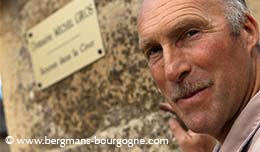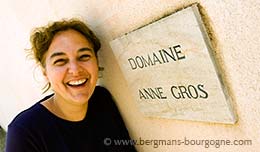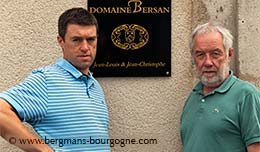
atrick Guillot runs a small domaine in Chamirey, a hamlet of Mercurey. He was the little brother who saved the domaine back in 1988 and ended up planting a pinot noir clone that wasn’t supposed to be commercially available.
Mercurey is the home of the big reds of the Côte Chalonnaise. It’s a large appellation. 655 hectares in total for both village appellation and premier crus.
Patrick’s grandfather created the domaine in 1942. At the time he had three hectares. He was a sharecropper, renting both vineyards and the buildings from a notary. Then, in 1960, the domaine was sold and an uncle of Patrick Guillot’s bought it.
 – By then my grandparents were too old to run the domaine, says Patrick Guillot. My uncle didn’t have any children, so when he passed away in 1977 my father bought it. Up until then he had been working for a caviste in Mercurey. He ran the domaine for ten years before I arrived.
– By then my grandparents were too old to run the domaine, says Patrick Guillot. My uncle didn’t have any children, so when he passed away in 1977 my father bought it. Up until then he had been working for a caviste in Mercurey. He ran the domaine for ten years before I arrived.
– Even when I was just a kid I did the harvest, I always worked in the vineyards. When my father bought the vineyards my two elder brothers had already left home, one to become a land surveyor and one to become a chef. My father said that if he was going to buy vineyards there had to be somebody there to take them on after him. So I went to Lycée Viticole in Beaune and graduated in 1983. Then there was my military duty, after which I worked for another domaine in Mercurey for four years.
With the exception of some Bouzeron all of Domaine Patrick Guillot’s vineyards are in Mercurey. The majority is red, but there is some white as well, and you’ll find most of his vineyards in the southern end of the appellation.
 – In 1988 a parcel in Chavances, which is village appellation Mercurey just behind here, came up for sale. As a young winegrower just starting out I was prioritized for buying. In addition to that my father let me his vineyards, three hectares, together with the building.
– In 1988 a parcel in Chavances, which is village appellation Mercurey just behind here, came up for sale. As a young winegrower just starting out I was prioritized for buying. In addition to that my father let me his vineyards, three hectares, together with the building.
Patrick Guillot then found another 75 ares of Mercurey to buy. Later on he bought another three parcels of Mercurey, as well as a plot in Bouzeron. Over the years Domaine Patrick Guillot slowly grew to 5,70 hectares.
– It is mainly red, he says. Out of the 5,70 hectares only 1,80 hectares are white (Bouzeron 1,30 ha and Mercurey blanc 0,50 ha). Since my arrival here I have changed a lot. Much, much more work is done in the vineyards. Much débourbage. No more weedkillers of certain types. I plough very much and the yields are more controlled now.
 – In Chavances I have roughly one hectare just behind the building here. Then there is another 40 ares a little bit further away, just 200 metres. There is lots of clay. The soil is deep behind the domaine, but as you move uphill there are more stones. One part was planted in 1957, another in 1963, and another one in 1988. There are a few more, but I don’t know when they were planted. They are at least 40-50 years old. And there are some young vines, around 20 years.
– In Chavances I have roughly one hectare just behind the building here. Then there is another 40 ares a little bit further away, just 200 metres. There is lots of clay. The soil is deep behind the domaine, but as you move uphill there are more stones. One part was planted in 1957, another in 1963, and another one in 1988. There are a few more, but I don’t know when they were planted. They are at least 40-50 years old. And there are some young vines, around 20 years.
The Mercurey Chavances is 100 per cent de-stemmed. Traditional vinification, with pigeage twice a day in the beginning. Later there is more remontage in order to avoid too hard tannins. Élevage is in barrels, with around 15-20 per cent new oak, depending on the vintage. All the reds here, from the Bourgogne rouge to the Mercurey premier crus, are made in the same way.
– It’s only the terroir that changes, says Patrick Guillot. The yield is the same for all appellations.
 – I have a parcel in En Boussoy, he continues. It’s village appellation Mercurey as well. Very small. Just 28 ares. It’s just across the border to the commune of Saint-Martin-sous-Montaigu. It’s very red soil. Lots of iron oxide. It looks like a tennis court in The French Open. The soil is not very deep, just 50 centimetres. En Boussoy is flat, a plateau. You have the premier crus Les Ruelles and Les Fourneaux on the slope below. Then on the slope above you have the premier cru Clos de Montaigu. En Boussoy is a nice little terroir, which produces a wine which is more on the spicier side.
– I have a parcel in En Boussoy, he continues. It’s village appellation Mercurey as well. Very small. Just 28 ares. It’s just across the border to the commune of Saint-Martin-sous-Montaigu. It’s very red soil. Lots of iron oxide. It looks like a tennis court in The French Open. The soil is not very deep, just 50 centimetres. En Boussoy is flat, a plateau. You have the premier crus Les Ruelles and Les Fourneaux on the slope below. Then on the slope above you have the premier cru Clos de Montaigu. En Boussoy is a nice little terroir, which produces a wine which is more on the spicier side.
Clos de Montaigu is the largest vineyard of Domaine Patrick Guillot, 1.30 hectare. Like in En Boussoy there is a lot of clay. Les Veley, the other premier cru of the domaine is on the slope behind.
 – In Les Veley I have both red and white, explains Patrick Guillot. 20 ares of white and 38 ares of red. The soil is not the same as in Clos de Montaigu. It’s white limey marl. While Clos de Montaigu really is soil just for red Les Veley works for both.
– In Les Veley I have both red and white, explains Patrick Guillot. 20 ares of white and 38 ares of red. The soil is not the same as in Clos de Montaigu. It’s white limey marl. While Clos de Montaigu really is soil just for red Les Veley works for both.
– We are just three who make white Les Veley. It’s François Raquillet (Domaine François Raquillet), Manu Bautista (Domaine Tupinier-Bautista, where it says Les Vellées on the labels) and I. Mercurey is primarily a red appellation, and I don’t have much white. Just 20 ares of premier cru and 34 ares of village appellation. The premier cru I planted 10-15 years ago, because 34 ares wasn’t enough. 50 is enough. It’s true that the people that come here they come here for the the reds, even if we have some really nice whites.
 – But if you ask Manu Bautista the whites are very important, he adds with a smile. I don’t know, maybe he has more clients that like white wine. But for me half a hectare is fine.
– But if you ask Manu Bautista the whites are very important, he adds with a smile. I don’t know, maybe he has more clients that like white wine. But for me half a hectare is fine.
– Above Touches you have Les Morins and at the northern end of the appellation you have Les Saumontes. Part of the latter is premier cru, but I’m in the village appellation part. Les Morins is facing south with a bit of clay. Les Saumontes is southwest, with silt and lots of small flat stones. It’s a very good place for white.
In Bouzeron, the home of the aligoté, Patrick Guillot bought an abandoned piece of land, an old orchard, back in 1988. He cleared it and planted vines instead of apple trees. It’s a nice slope at the southern end of the appellation, towards Rully. The lieu-dit is Les Bouillottes.
 Then there is the story behind the red Cuvée Les 3 Louves. Louve is French for female wolf. The first vintage was in 2005, but the story goes back a lot further.
Then there is the story behind the red Cuvée Les 3 Louves. Louve is French for female wolf. The first vintage was in 2005, but the story goes back a lot further.
– In 1988 I bought an abandoned vineyard in Clos de Montaigu. When I went to the nurseryman he didn’t have the pinot noir clone I was looking for. I wanted the 828 clone. He told me he had the 943 clone. He didn’t know much about it, but it was a good quality clone, he said. So I ended up planting that one instead.
– Years later I came to work with the Chambre d’Agriculture in Saône-et-Loire and their œnologist with Luc Cadel. We did many experiments on how to work with this treatments, how to deal with diseases etc. It was very interesting work during four-five years. One day he let us try something from the experimental vineyard. It was the clone 943, which he said wasn’t commercially available. But I had planted it 15 years earlier.
– He got in touch four years later and asked if I would consider vinifying the parcel separately. Their experimental vineyard was regional appellation and they were interested in how the clone behaved in a premier cru setting.
– He lent me a small tank, because it’s not much in terms of quantity. For the élevage I took one new barrel, one one year old and one two years old. Initially the plan was to blend it with the main Clos de Montaigu, but it was so good I decided to make a separate cuvée.
– The name. We’re in the hamlet of Chamirey. The nickname for the people here is les loups de Chamirey, the wolves of Chamirey, because back in the day they were people who kept very much to themselves. So my wife and two daughters are the 3 Louves. Voila!
© 2025 Ola Bergman














